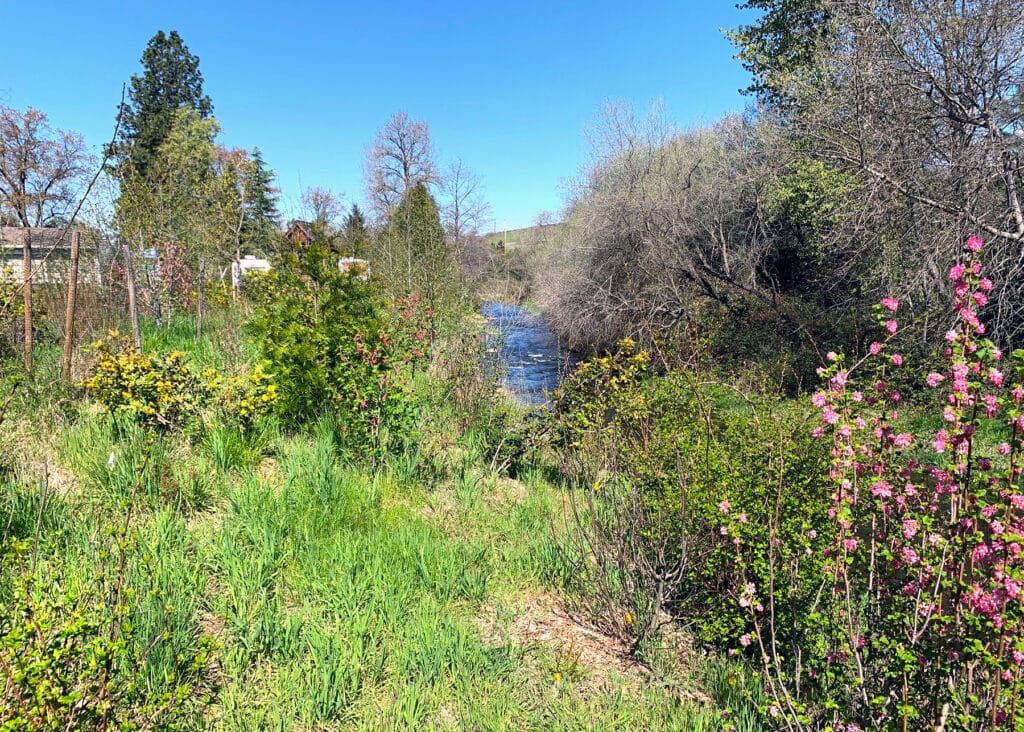TFT Completes Streamside Forest Restoration in Bear Creek for Improved Salmon Habitat
April 15, 2024
Partnering with the City of Ashland, The Freshwater Trust (TFT) has successfully implemented streamside vegetation projects to keep the water cool for native fish in Oregon’s Bear Creek, a tributary of the Rogue River.
The 215-mile Rogue River flows through Southwestern Oregon from the Cascade Mountains to the Pacific Ocean. Bear Creek, one of the upper Rogue’s major tributaries, is the most urbanized stream in southern Oregon, flowing through five cities before its confluence with the Rogue River. Despite decades of urban development along this stream, it continues to support salmon and steelhead, including federally listed Southern Oregon Northern California coho.
Unfortunately, the 2020 Almeda and Table Rock Fires scorched over 200 acres of riparian (streamside) forest between Ashland and Central Point. In addition to causing significant damage to surrounding communities, the wildfires also killed many mature trees, leaving Bear Creek more exposed to sunlight and the soils bare of any vegetation.
How Water Quality Trading Works in Bear Creek
Five years after contracting with Ashland, The Freshwater Trust has successfully implemented 10 riparian restoration projects that will meet Ashland’s obligation to offset the impacts of its clean, but warm, wastewater discharge on Bear Creek.
Under the Clean Water Act, a wastewater treatment plant that discharges to a waterway like Bear Creek must operate according to a permit intended to protect water quality. In the case of temperature in Oregon, limits are designed to ensure warm discharges do not harm imperiled salmon and steelhead. Streamside restoration of native vegetation creates shade that blocks solar load (sunlight) from hitting the surface of the water. These shade projects—if rigorously designed, implemented, and managed—can be used by a wastewater treatment facility to comply with its permits.
This approach is called water quality trading, and Ashland’s trading program blocks more than 135 million kilocalories (kcals) of sunlight per day from hitting Bear Creek during critical spawning, rearing, and migration times for these fish.

To implement the best shade restoration projects, TFT uses its StreamBank® BasinScout® technology to identify the projects that will reduce the most solar loading for the least cost. This approach is critical for cities and other water utilities that must demonstrate to their communities and ratepayers that they are maximizing benefits with their funds.
“Water quality trading is a data-driven approach that helps communities comply with the law and create healthier rivers that their communities can see,” said Tim Wigington, vice president of finance and policy at The Freshwater Trust. “Using a model approved by the state, we quantify how much shade from tall trees will block how much sunlight from hitting the stream.
More than 35 acres of native trees and shrubs were planted along Bear Creek streambanks from 2020 to 2024, many of which have helped the waterway to heal after the devastating fire damage. Project locations range from Ashland to Central Point, with at least one project in each locality along Bear Creek. Each site was strategically selected to reduce the maximum amount of solar load on the stream for each dollar spent.
“Our water quality trading program protects water quality along Bear and Ashland Creeks and keeps us in compliance with the Clean Water Act,” said Scott Fleury, City of Ashland public works director. “Moreover, this green infrastructure appreciates for decades as functional habitat for salmon and wildlife.”
The restored sites have created anchors of high-quality riparian habitat throughout Bear Creek, addressing the critical need for stream shade. The projects also add habitat for the river’s salmon runs, improve water quality, and create resilience for the communities along Bear Creek.
“We knew this program could make an important contribution to wildfire recovery efforts in the region,” said Eugene Wier, restoration program manager for The Freshwater Trust. “Our staff and partners worked diligently to meet the ecological goals of the program and the ecological needs the communities faced with rebuilding homes and businesses.”
The largest restoration site is 11.6 acres in a 75-foot-wide strip along the Bear Creek Greenway in Jackson County. In 2022 TFT and local subcontractors removed invasive weeds such as Himalayan blackberry, vinca, and poison hemlock. Then teams planted an average of 2,000 native trees and shrubs per acre on the south side of the creek—more than 13,000 total. Trees planted include big leaf maple, Oregon ash, black oak, black cottonwood, incense cedar, Ponderosa pine, Douglas fir, and chokecherry. Shrubs planted include mock orange, skunkbush, Pacific ninebark, Oregon grape, Douglas spirea, and red flowering currant. Habitat created by the plants has encouraged pollinators, deer, otters, egrets, and bald eagles to use the space. In a few years, the plantings will be well established and begin forming a shade canopy over the creek.
At sites planted in 2020, some trees are already 15 to 20 feet tall.

Along the banks of Bear Creek, TFT planted a dense mix of carefully selected native trees and shrubs that provide structure, diversity, and create a canopy of shade over the water.
By the Numbers: Ashland’s Bear Creek Restoration
- 10 managed sites along Bear Creek and Ashland Creek
- 62,960 native trees and shrubs planted along 37.3 acres of streambanks
- 24,052 feet of stream restored
- 0.5 miles of livestock exclusion fencing installed
- 139.6 million kilocalories of solar load blocked (delivered ahead of schedule and exceeding the 135 million kcals required)
The Freshwater Trust will continue monitoring and stewarding these 10 projects until 2044 to ensure that their shade benefits persist. This longevity and the performance standards each site must meet are the real power of a water quality trading program.
“With 20-year life spans, rigorous standards, and independent reviews, these restoration projects are some of the highest-quality riparian restoration projects developed,” said Wier.
“Planting trees is the start, but long-term stewardship is what grows the forest and turns it into a community asset that keeps appreciating in value.”
In addition to delivering on the City’s permit obligation, TFT has successfully leveraged the trading program to help secure more than one million dollars of restoration funding for the Bear Creek watershed. For example, in 2023, TFT used the Ashland riparian sites to secure grant funding from the Oregon Watershed Enhancement Board to restore riparian habitat on an additional 50 acres of wildfire-damaged land.
TFT also currently has contracts with the Bureau of Reclamation, Bureau of Land Management, Jackson County, Oregon Department of Transportation, and City of Medford for restoration work throughout the Rogue basin.
#Ashland #Bear Creek #native trees #Oregon #quantified conservation #riparian restoration #Rogue River #Rogue River Basin #water quality trading
